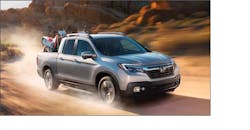Honda's Hot, New Ridgeline Is a Pickup Truck for Grownups
Author: Kyle Stock
Here’s something you will probably never hear at the local Home Depot: "I just want a pickup that’s more like a boring sedan."
Trucks trade in toughness. At least, that’s what decades of Detroit marketing have told us. They are supposed to be larger and more capable than one could ever require–like a Super Wal-Mart or The Rock. It’s the American way, and pickups are still a uniquely American thing. (The government changed the tax code 50 years ago to make it stay that way).
Yet Honda Motor Co. has just started selling an all-new Ridgeline pickup that seems like the love-child of an F-150 and an Accord . It’s more unassuming—shorter and squatter—than any other pickup on the market. Its grill isn’t an exercise in maximum chrome. And it’s a drama-free pleasure to drive, which is hard to say about anything with a cargo bed. After just three months, it’s selling like crazy.
Critically, the body and chassis are baked together on the Ridgeline, rather than bolted onto one another like those of every pickup made since Prohibition. The so-called body-on-frame construction of a traditional pickup tends to deaden rough terrain, but it also detaches the driver from the regular road, with the vehicle leaning and lurching and swaying.
Consequently, driving a contemporary pickup is not unlike talking to a weightlifter at your gym: Both constantly remind you how much they like working out. The Ridgeline doesn’t do this. It drives like a car—like a swollen Accord, to be precise. This, more than anything else, sets it apart.
Bill Visnic, editorial director of the Society of Automotive Engineers, said this is one of the few pickups he would feel comfortable driving up to the front of a fancy restaurant. "The Ridgeline does everything a casual driver needs and appears to be a little more mature approach to selling someone a truck," he said. "Full-sized pickups these days are almost laughably over-engineered."
Given its target demographic, we put the Ridgeline through its paces in a different kind of rough terrain, and had our loaner delivered to us in Midtown Manhattan. Its stubbiness proved useful for slipping between lanes and, once the crush of New York traffic opened up, slaloming through the tight curves of the FDR Drive. As opposed to its larger American cousins, driving the Ridgeline wasn’t a nerve-wracking exercise in gauging body-lean or avoiding deep manholes in order to keep the rear planted. Considering that four-doors are standard, the Ridgeline, in short, is Uber-capable.
Over the weekend, the rig was enlisted to help an elderly relative clean house in Connecticut. The schedule was simple: an outgoing load to Goodwill, an incoming load from Target, repeat. It wasn’t ranch work, but some of the piles were Texas-sized, and the Ridgeline handled big, heavy furniture with ease. What’s more, there was plenty of room for the requisite Labrador Retrievers, thanks to Honda’s "magic" seats, which allow the bottom portion to flip vertically.
"We spent a lot of time looking at how the truck would actually be used, vs. how people say they use a truck," Honda spokeswoman Jessica Pawl said. "It’s more of a DIY, home-improvement sort of slant."
As for gripes, the Honda isn’t a light pickup. As such, it isn’t appreciably more efficient than other trucks in its class, with a standard 19 miles per gallon on city streets and 26mpg or so while cruising. And when it comes to steering, the Ridgeline approximates a sedan too closely: The wheel is downright buttery, providing scant feedback.
While the Ridgeline may not look like a traditional truck or drive like one, it does act like one. It can carry up to 1,600 pounds, tow 3,500 pounds, and its standard V-6 engine provides a respectable 280 horsepower. A buyer diligently checking specs will find those numbers as good or better than those put up by the Chevrolet Colorado or Toyota’s beloved Tacoma.
And there are plenty of buyers. The Ridgeline starts at $29,000 and steps up in trim levels to $44,000. Since hitting the market in June, they are selling as soon as they hit dealerships, according to Pawl.
Honda engineers also came up with two tricks that those trucks lack. They lined the bed with speakers and tucked a cargo hold into it. Honda calls this an "in-bed trunk," but pragmatists, noticing the drain, will know it only as a cooler. To drive the point home about the Ridgeline’s intended audience, Honda has made a pickup in which its best features are evident when the bed is empty. Buyers who never do anything trucky will still feel great about their purchase: It’s a rolling party trick.
"We’re not going out to appeal to the devotees of the F-150," Pawl said.
Meanwhile, the mid-sized-truck slice of the market has been growing fast, which suggests that the Ridgeline is bringing in consumers that would otherwise be buying SUVs. It’s no surprise that Hyundai recently gave the green light to a small, car-like pickup of its own.
Making an outlier in the auto business is a gutsy thing. Car shopping tends to happen by comparison and, as such, a vehicle that looks and feels drastically different from its competitors runs the risk of not being considered at all.
Of course, risk can equal reward, especially if it drives this well.
About the Author
Bloomberg
Bloomberg delivers business and markets news, data, analysis, and video to the world, featuring stories from Businessweek and Bloomberg News.

